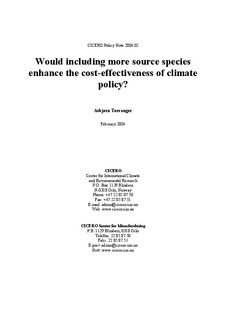| dc.contributor.author | Torvanger, Asbjørn | nb_NO |
| dc.date.accessioned | 2014-03-17T14:28:43Z | |
| dc.date.available | 2014-03-17T14:28:43Z | |
| dc.date.issued | 2004 | nb_NO |
| dc.identifier.issn | 0804-4511 | nb_NO |
| dc.identifier.uri | http://hdl.handle.net/11250/191794 | |
| dc.description.abstract | Incorporating ozone precursors and particle emissions in future climate policy agreements could improve the level of cost-effectiveness, but would also add complexity and complications to negotiation, reporting and implementation. To assess the cost saving potential, a case study of Norway is carried out. Only NMVOC and NOx are included, since data for the other species are not available. It turns out that the potential for reducing emissions of these gases is limited, and in the range of 4 to12 % of the potential of the six gases included in the Kyoto Protocol. One must be careful when trying to generalize the results from Norway to other countries. | nb_NO |
| dc.language.iso | eng | nb_NO |
| dc.publisher | CICERO Center for International Climate and Environmental Research - Oslo | nb_NO |
| dc.relation.ispartof | CICERO Policy Note | nb_NO |
| dc.relation.ispartofseries | CICERO Policy Note;2004:02 | nb_NO |
| dc.title | Would including more source species enhance the cost-effectiveness of climate policy? | nb_NO |
| dc.type | Working paper | nb_NO |
| dc.source.pagenumber | 6 | nb_NO |
